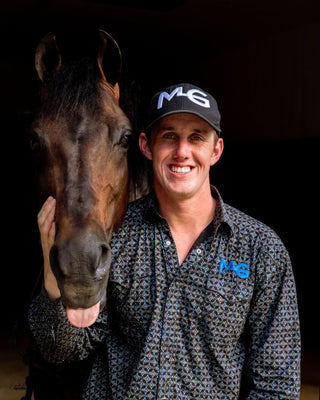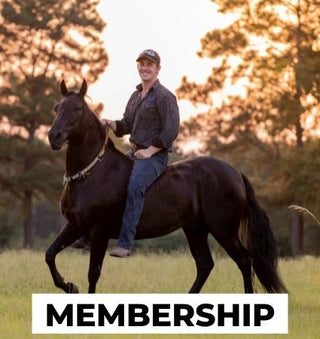Watch the Video Here or continue reading below!
Backing up might seem like a simple maneuver, but when it comes to advanced horsemanship and improving your horse’s overall performance, a well-guided backup is crucial. In today’s Performance Series video, we’re diving into how to get your horse to not only back on cue but to guide backward with control and intention.
Why a Strong Backup Matters
A solid backup is more than just a trick—it's the foundation for collection, balance, and refinement. Backing helps build engagement through the hindquarters, develops responsiveness, and improves transitions in all disciplines. As I learned from Stacy Westfall, backing with intention can unlock your horse’s full athletic potential.
“Just like Mr. Miyagi, she had me backing up all day long... eight hours of nothing but backup drills.”
First Things First: Independent Backing
Before you work on guiding, your horse should already know how to back independently. That means you ask once, and they continue backing until told otherwise. This foundational skill ensures the horse isn’t relying on you to micromanage every step, freeing you up to begin guiding.
The Misconception About Movement
When guiding in reverse, many riders mistakenly try to swing their horse’s hind end, moving the hips too much. That disengages the motor—the hindquarters. Instead, you want to guide with the front end, steering with the shoulders just as you would moving forward.
-
Keep the hind legs under the horse
-
Steer using legs and reins in harmony
-
Guide without dragging or pulling
How to Guide the Backup: Step-by-Step
1. Sit Straight and Look Ahead
Just like backing up a car using a rear-view camera, keep your body straight. Don’t look over your shoulder or down. Look forward and use your peripheral vision to navigate.
2. Use Legs and Reins Together
Whether riding one-handed or two-handed:
-
Two reins + two legs = straight backup
-
To turn: Remove one leg and open one rein
-
To straighten: Put the leg and rein back on
“Take a leg off, he starts to turn. Put the leg back, he stops the turn.”
3. Build the Pattern Through Repetition
Start by working one direction until the horse understands. Back straight for a few steps, then turn hard, then straighten again. Use clear body cues and reward precision.
-
Back straight → Turn left → Back straight
-
Back straight → Turn right → Back straight
Consistency helps your horse understand when to turn and when to stay straight.
Common Mistakes to Avoid
-
Pulling your horse backwards: This creates resistance.
-
Looking down at obstacles: This misaligns your posture and throws the horse off balance.
-
Not practicing enough: Like anything, guiding takes reps.
Why Head Position Matters
A low, relaxed head encourages your horse to round their back, creating more freedom and space for the hind feet to step under. If their head is high, it’s harder for them to shift their weight and guide smoothly.
Real Progress Comes from Practice
This was only the second session for the horse in the video, but he was already showing promise. Why? Every ride includes 300+ feet of backing. The more comfortable your horse is moving in reverse, the easier it is to start guiding.
“The more you backpedal, the easier it is to backpedal.”
Final Thoughts
Guiding the backup is a skill that opens the door to advanced patterns like figure eights, serpentines, and L-shaped courses. It enhances responsiveness, sharpens your horse’s understanding of cues, and builds a stronger partnership. Start small, be consistent, and your horse will be guiding backward like a pro in no time.









